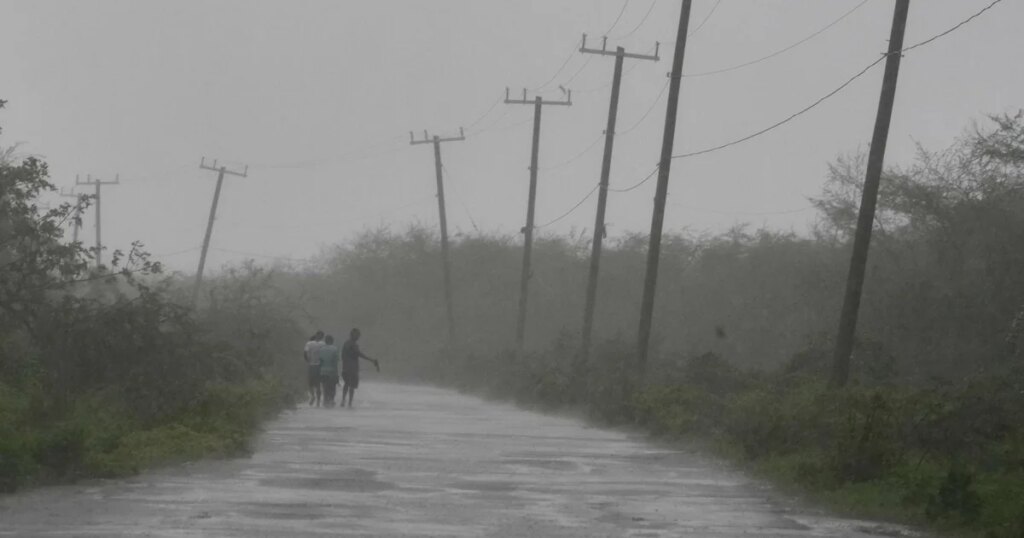Hurricane Melissa made a historic landfall on Tuesday in Jamaica, registering as a Category 5 storm, the most powerful to hit the island since record-keeping began. The hurricane brought devastating winds and heavy flooding, particularly across Jamaica’s southwestern regions. With sustained winds of 185 mph at its peak, officials predict catastrophic damage and are urging residents to prepare for severe impacts as the storm nears Cuba and the Bahamas.
| Article Subheadings |
|---|
| 1) Overview of Hurricane Melissa’s Impact |
| 2) Damage Reports and Casualties |
| 3) Preparations and Evacuations |
| 4) Forecast and Path of the Storm |
| 5) International Response and Aid |
Overview of Hurricane Melissa’s Impact
Hurricane Melissa, which made landfall on Jamaica, is noted for being the strongest hurricane to strike the island since records began in 1847. According to the National Hurricane Center, it approached Jamaica with sustained winds of 185 mph, categorizing it as a Category 5 storm at its peak. This severely powerful storm triggered numerous alerts and warnings from local meteorological agencies due to the anticipated extensive destructive effects. As it neared land, Melissa not only intensified concerns among residents but also drew attention from global weather experts who emphasized its potential to cause unprecedented damage.
Damage Reports and Casualties
As Melissa struck, preliminary reports indicated widespread devastation throughout Jamaica. Minister of Local Government, Desmond McKenzie, reported that over 530,000 Jamaicans had lost power by Tuesday evening. Infrastructure sustained severe damage; for instance, part of the roof of Black River Hospital was compromised, prompting the evacuation of 75 patients. Tragically, preliminary data shows that at least seven fatalities have been associated with the storm, including three in Jamaica. These developments highlight the catastrophic nature of Melissa and the need for an organized response to the emerging humanitarian crisis.
Preparations and Evacuations
In anticipation of Melissa’s landfall, the Jamaican government undertook extensive preparations. Prime Minister Andrew Holness emphasized that no infrastructure in the region could withstand a hurricane of this magnitude, indicating the urgency surrounding evacuation efforts. Many residents were urged to seek higher ground and evacuate flood-prone areas. Despite the government’s orders, reports from aid organizations indicated that many families chose to shelter in place, often due to fear and uncertainty surrounding the situation. Mercy Corps advisor, Colin Bogle, reported that many were terrified of losing their homes and livelihoods, resulting in a complicated dynamic between official guidance and public action.
Forecast and Path of the Storm
After making landfall in Jamaica, Hurricane Melissa continued to weaken but remained a significant threat. Forecasts indicated that the storm would transition to the eastern parts of Cuba by early Wednesday morning. The National Hurricane Center predicted that the storm would still retain substantial strength as it traveled north-northeast to the southeastern Bahamas later that evening. While Jamaica endured the immediate impacts, the continued trajectory of the storm raises concerns for other regions, including possible life-threatening flash flooding and landslides due to intense rainfall.
International Response and Aid
Internationally, officials from the International Federation of Red Cross and Red Crescent Societies warned that Melissa could impact approximately 1.5 million residents in Jamaica alone. Aid organizations are actively monitoring the situation, preparing to deploy resources as needed. The U.S. State Department issued natural disaster travel alerts for Cuba, Jamaica, Haiti, and the Bahamas, advising American citizens to evacuate or prepare to shelter in place. Hundreds of thousands of people began evacuating affected regions in Cuba as part of coordinated emergency measures. Preparations included securing food and clean water supplies, with health officials urging the population to conserve the limited resources available.
| No. | Key Points |
|---|---|
| 1 | Hurricane Melissa reached peak winds of 185 mph, marking it as one of the most powerful storms recorded. |
| 2 | Casualties reported include seven deaths across Jamaica, Haiti, and the Dominican Republic. |
| 3 | Over 530,000 Jamaicans are reported without power, with significant damage to infrastructure. |
| 4 | Evacuation orders from the government faced challenges as many residents remained in place due to fear. |
| 5 | International aid agencies are preparing responses to assist millions affected by Melissa. |
Summary
Hurricane Melissa has had an unparalleled impact on Jamaica, marked by historic wind speeds and extensive damage. As the storm continues its path towards Cuba and the Bahamas, the challenges existing for affected populations escalate. With lives lost and infrastructure severely battered, the need for comprehensive support and recovery efforts will be critical in the coming weeks. Officials and aid organizations are mobilizing resources to address the ongoing crisis and mitigate further impacts, particularly as the potential for additional flooding looms.
Frequently Asked Questions
Question: What were the peak winds recorded for Hurricane Melissa?
Hurricane Melissa reached peak winds of 185 mph, categorizing it as a Category 5 storm at its peak.
Question: How many casualties have already been reported due to Hurricane Melissa?
At least seven fatalities have been reported across Jamaica, Haiti, and the Dominican Republic due to the hurricane.
Question: What preparations were made by the Jamaican government prior to the storm’s landfall?
The Jamaican government undertook extensive preparations, including evacuation orders for residents in high-risk areas and warnings about potential catastrophic damage.
